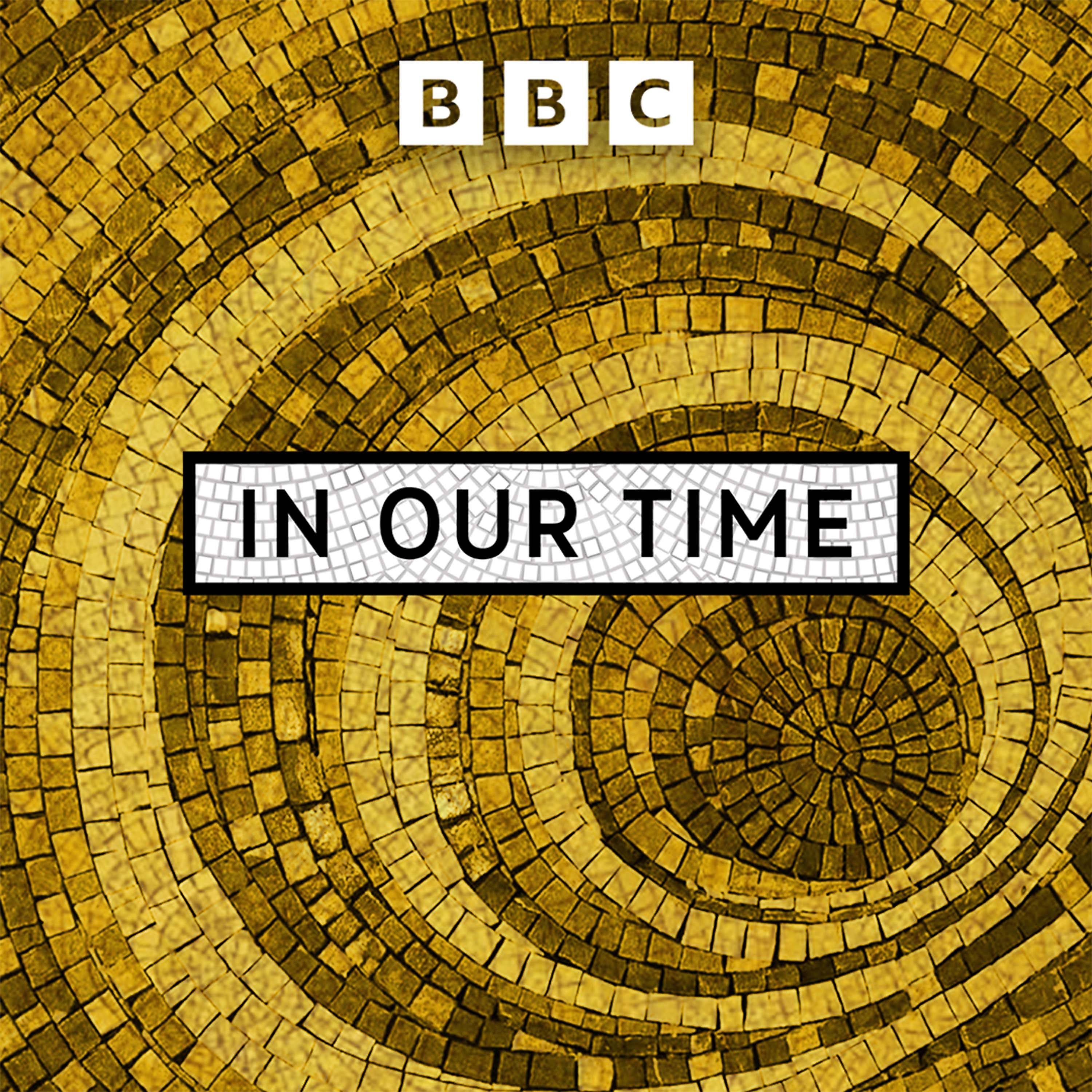
Charles Dickens: A Brain on Fire! 🔥
Guests include: Stephen Fry, Miriam Margolyes, Armando Iannucci, Alice Loxton, Robert Douglas-Fairhurst, Lucinda Hawksley, John Mullan, Pen Vogler, Andrew Davies, Rosie Holt, Bernard Cornwell .... and many more academics, writers, actors, directors and descendants of the great man himself!
Along side these interviews there are special Dickens readings from across his works ...
Thank you for listening 🔥
Charles Dickens: A Brain on Fire! 🔥
(Encore!) The Lost Portrait: with Emma Rutherford
Dominic’s guest today is the inimitable Emma Rutherford who recalls her time working on the rediscovery of a lost portrait of Dickens, painted by Margaret Gillies in 1843, and lost for over a century until its serendipitous reappearance at a South African auction. A pivotal snapshot of Dickens' life, the portrait's story hints at the profound bond between Gillies and Dickens, a bond that may have helped shape A Christmas Carol
Emma is an art historian, with a specialisation in portrait miniatures and silhouettes. Emma began her career at London’s Victoria & Albert Musuem, and then for 15 years established and ran the Portrait and Miniatures Consultancy at Philip Mould’s & Company
This year she has set up The Limner Company
Her publications include Without Hands The Art of Sarah Biffin … a topic for a future episode!
This episode was originally broadcast on 19th December 2023
If you'd like to make a donation to support the costs of producing this series you can buy 'coffees' right here https://www.buymeacoffee.com/dominicgerrard
Thank you so much!
Host: Dominic Gerrard
Series Artwork: Léna Gibert
Original Music: Dominic Gerrard
Thank you for listening!
Hi everyone. Today's guest has an extraordinary tale to tell because, at this time of the rolling year, she vividly remembers the pivotal role that she played with Philip Mould in bringing back to London an incredible portrait, painted in 1843, of a 31-year-old Charles Dickens on the brink of either roaring success or crushing failure. Mould's was writing Martin Chuzzlewit when he sat for this painting, and it wasn't going well. On top of that, he just decided to start working on a ghostly little book for Christmas. His publishers weren't impressed with this idea, but he pressed on regardless, and what he published on the 19th of December that year would change his reputation, fortunes and legacy as a writer forever.
Dominic Gerrard:This portrait, painted by Margaret Gillies who, incidentally, absolutely deserves her own episode captures what our guest describes as the knife-edge moment, where Dickens' bright expression betrays an anxiety about his future and whether, like Scrooge, he will be able to change the course of his life. Sometime after this portrait was displayed at London's Royal Academy in 1844, it disappeared and was truly lost for 130 years, until six years ago when it surfaced at auction in South Africa in a tray stuffed with some truly worthless objects and in very poor condition. So this is the story of how a painting was recalled to life and even saved from deliberate destruction, how it travelled over seven and a half thousand miles from South Africa to where it now hangs above Dickens' writing desk at the Charles Dickens Museum in Doughty Street.
Dominic Gerrard:And sharing this story with us is the inimitable Emma Rutherford, who is an art historian with a specialisation in portrait, miniatures and silhouettes. Emma began her career at London's Victoria and Albert Museum and then for 15 years, established and ran the Portrait and Miniatures Consultancy at Philip Moldsen Co, and this year she has set up the Lymna Company. Her publications include Without Hands, the Art of Sarah Biffin, and I think I might have persuaded her to come back and talk to us about that next year. Fingers crossed, it's now time to meet Emma. Emma, hello, welcome to Charles Dickens' A Brain on Fire. It's wonderful to have you here.
Emma Rutherford:Thank you so much for asking me to come on and talk to you.
Dominic Gerrard:Well, I'm really thrilled you're here because you're going to talk about the so-called lost portrait of Charles Dickens, which you told me when we were speaking in the run-up to. This is something that you tend to think about quite a lot at this time of year. Could you explain to us a little bit about that and why that is?
Emma Rutherford:Yeah, of course. I mean the lost portrait was painted during the time that Dickens was writing Christmas Carol, and so the whole thing for me is totally bound up with Christmas, and we launched the portrait to the public at Christmas, having kept it a secret for ourselves for a year as well. So, yeah, this time of year I always think about Dickens and Christmas Carol and it almost does to me what Christmas Carol I think did to the public when it was published. It sort of slightly brings me to my senses about Christmas and I stop complaining and I try and be a bit more charitable, and so it really is still having an effect on me. But yeah, the portrait itself is very much bound up with Dickens and that absolute moment in his career, very short moment where he's writing Christmas Carol. So of course it's absolutely totally connected.
Dominic Gerrard:Yeah, gosh. And how did you first hear about the portrait and then? How on earth did you manage to keep it to yourself for a year?
Emma Rutherford:Well, part of how I kept it to myself for so long was because I didn't get to see it for about in person for about six months after I received an email about it. So I didn't physically have the portrait for quite a long time, which is a bit of a tale in itself. But yeah, I received an email. I was consulting for the Philip Mould Gallery. I was there for for 15 years I've only just had a year now of working on my own as a dealer, but I was. I was working for Philip Mould at the time and he has this very well known BBC programme with Fiona Bruce called Fake or Fortune, and it meant that lots of people would write in speculatively with portraits, hoping that this sort of grotty thing in Granny's attic was going to be a fortune and not a fake.
Emma Rutherford:And there was this delightful man in South Africa who kept sending me pictures of miniatures, knowing that that was my specialist area, and most of the time I was writing back to him saying I'm really sorry, I'm afraid this is another dud, but much more professional in that. But but then he sent me this image and he said look, I've been to my local auction and I've paid £27 for a box of miscellaneous items, and that is literally how the auctioneer described it. He said there was an antique shop which closed down and they just put everything through auction. But most of it was so awful that it was, it was just boxed up. So I think the portrait was in with things like a lobster jelly mould, and I mean really, really, they literally just chucked into box. So he sent me an image of this portrait and I was like, oh, here we go again, but, and it was this horrible moldy thing.
Emma Rutherford:But and I I see so many miniatures and I have seen so many miniatures. You know I've been specialising in them for, I think, 27 years now. So it takes quite a lot for me to think, oh, hang on, a minute, there might be, might be something here, particularly a Victorian miniature, because once photography comes in, you know, they start to become irrelevant and the quality starts to really go downhill. So so this is sort of, you know, around the dawn of photography, this, this portrait. But I thought, god, that it just looks there's something about it, something about it. So I even I sent it to Philip, I sent it to my colleague Lawrence, and then sort of started googling around that date. And then I got an email from this guy who sent it to me, said and saying look at this, and he'd found the engraving which relates to the portrait. So I said, oh right, fine, here we are. Then this is a copy after the engraving, which was engraved for a book, and and that's what I thought, but the quality does look really good.
Dominic Gerrard:So you could see that even through the kind. Did he wipe away any of the mold off the frame? I mean, what did it look like in the image?
Emma Rutherford:it was. I mean, I don't know if you've seen any images of what it first looked like.
Dominic Gerrard:I've got your book here, which you did with Philip mold yes, I've got the fantastic. Of course, here's the image of his face, but yes, listeners can't see it, but I'll. There'll be links to purchase this. No, the before and after is probably one of the most extreme makeovers it's amazing because Dickens, the young Dickens, is kind of looking out through a fogged up window almost with the glass over the.
Emma Rutherford:Yes, in fact, once we realized it could be something exciting, the guy in South Africa was like so I've taken it apart and I was like yeah, but on the radiator to dry now yeah, I thought he was gonna say you know, pop to the washing machine, leave it alone, but he did disassemble it and actually that was quite helpful.
Emma Rutherford:But yeah, I mean, I went to the London library and I basically sat and flick through every single biography of Dickens and Was the? This engraving, which clearly related to the portrait, just appeared again and again and again. There was nothing like this portrait miniature. So I then started reading about it and and I came across a website which which said the interesting miniature by Miss Margaret Gillies has mysteriously disappeared and is not improbably buried in some private collection. It was exhibited in the Royal Academy in 1844.
Emma Rutherford:I went back to the Royal Academy lists and could see, yes, it was there by this artist called Margaret Gillies, who hadn't really had very much to do with before in 1844. So I was beginning to think, my goodness, that this could be the portrait that, yeah, and it's in South Africa and it's on ivory, which, yes, which you can't just post from South Africa. So, yeah, one the reasons I didn't say it for so long was because trying to persuade the South African authorities to Do the correct paper, to send the portrait over to us was was a massive challenge and we were basically talking to the people who deal with elephant poaching and that sort of thing and people wanting backhanders to. I mean, it was yeah, it was extraordinary journey, I think, dickens.
Dominic Gerrard:A bit a bit a little bit of a spy novel kind of thing happening here possibly.
Emma Rutherford:Yeah, actually, I just remember it being incredibly stressful. But yeah, we in fact we even got it transported overnight to a friend of Philip molds in Cape Town because when it was in in the towel it was just too exposed to that they were threatening to destroy it and because it was on ivory and yeah, we just had to get away from Some officials who were threatening that.
Dominic Gerrard:So yeah, you say it's on ivory, so, in terms of the materials and the component parts of it, which part of it is it? The entire? Yeah?
Emma Rutherford:it's the support for the watercolour. So all miniatures from the early 18th century painted on on ivory and that tradition just continues right the way through to the mid 19th century. So it's completely normal. Unusual the only ones are on vellum Partiment and then the later ones on ivory so obviously to park the serious morality of using ivory aside for one moment.
Dominic Gerrard:what was the benefit of using ivory? What was the reason for painting on those?
Emma Rutherford:It's quite difficult to determine and and it wasn't like somebody just an artist woke up and had a eureka moment said why don't we use ivory? It sort of gradually replaced vellum as a, as a precious material where the surface could never be particularly big, you know, because you've got to work with the size of a task yes.
Emma Rutherford:But you see the early miniatures on ivory and unless you're a specialist you couldn't tell that there was ivory under the paint. It's very Strange. But then later in the 1780s they start to use ivory showing through a little bit for some skin tones and that sort of thing. But of course now it's. It's a really demonised Material and quite rightly there's there's a massive progress towards, well, a little bit of progress towards stopping the poaching of elephants. But luckily with the Miniatur's ideal was you can tell the age and yeah, they're not from recent times but yeah, it's completely normal to use ivory as the support.
Dominic Gerrard:Okay, so in our story, in your story, in this whole saga for you, the portrait has moved to Cape Town. Is it still covered in mould? If you've persuaded people to stop trying to clean it, stop trying to do anything helpful.
Emma Rutherford:It did travel to Cape Town in several parts, Because by now I'd also looked at the frame it was in and recognised that that sort of your listeners will hope you'll be able to see images of. This rather fancy Victorian metal frame was one that Margaret Gillies, the artist, had used on other portraits, so I didn't want the owner to throw any component parts away because it looked as though part of the original frame was also still there.
Dominic Gerrard:So that was another clue that it was her. It was her original, yeah. And the frame itself. I mean, was it quite a standard? You're an artist, you can get a frame like this ready made, and it's quite typical from the 1840s. Or is there anything particularly special about this frame?
Emma Rutherford:No, but it is the sort of fancy frame you would use if you're exhibiting at the Royal Academy and you wouldn't use a plane frame. It's often quite easy to tell which. When you get a miniature in a frame like that, you think the Royal Academy is somewhere. You would check the records because it wouldn't have been a cheap frame, but it would have been. It's not specially made for that miniature, but the other components of the frame would have been so. But now this is from a mould.
Dominic Gerrard:Right. So when do you get to see it, Emma? When do you actually get to physically hold it and look at it?
Emma Rutherford:So the email from the owner was October 2017, and it arrived in London in summer 2018. And because it's ivory, it needed to. We need to get paperwork so that we could correctly import it into this country. I mean, I was guessing it was ivory because I hadn't actually seen it. In fact, we didn't. We had no idea whether it was potentially a copy. It still could be, because it was so obscured by all this dirt that you just couldn't really tell the quality of it.
Emma Rutherford:But I think somebody filmed me unwrapping it summer 2018. Right, yeah, I was so. Yeah, such a mix of emotions. But as soon as I saw the real thing, it was actually. It's funny how your sense of scale can often be really confused when you've only seen images of something and you know it was really big and bold and those eyes were still kind of drawing me in. And I could also see that it was definitely by professional artists, because painting on ivory is not easy, and the quality I could see was there and, amazingly, I could also see that it could be cleaned and conserved back to how it would have originally looked. So it's huge relief once it was finally in London.
Dominic Gerrard:Yes, gosh, so you're unwrapping it, and so it has the glass frame over the actual paint surface itself, but had mould got in underneath the glass onto the surface.
Emma Rutherford:Yeah Well, the problem with mould on watercolour on ivory is that it eventually will sort of eat the paint itself. So until we got it in front of a conservator and under a microscope we weren't sure how much of the original painting was left. But it was as though the mould itself respected Mr Dickens and the face was completely untouched. It was mainly areas in the jacket that had disintegrated. So the black, just to be technical, the kind of the gum Arabic in the watercolour paint which made it almost look like oil paint at this period, is very, very. The mould is very attracted to that gum and the gummier areas were in the thicker paint on his black jacket. So that was the area that was.
Dominic Gerrard:Gosh, what a relief that's great. So essentially his jacket attracted the mould away from his face.
Emma Rutherford:Wow, it's always a warm black. Yes, yeah, that seemed to be the case, but amazingly, the face I could see I mean even there, and then I could have brushed the mould off the face and it would have been perfect. So huge relief.
Dominic Gerrard:By this point. Obviously you know that it's not a copy or a fake, Do you?
Emma Rutherford:I don't know 100% at this point, but by this point I had been to the Dickens Museum and spoken to their very knowledgeable curatorial team and anybody else really who would talk to me about Dickens. So yeah, I contacted. You know, living authors had written biographies of Dickens. I'd been through archives and letters at the Dickens Museum where I found the letters between Margaret Gillies, the artist, and Dickens setting up the sittings for this portrait and trying to sort of pull it all together. But really, until I wrapped the portrait I really I really didn't know. I mean, my hunch was from that sort of sucker punch it gave me when I first opened the email that it was going to be the lost portrait. But there's, you have to have an element of doubt, Otherwise you're not not really an art historian. You know. You have to, really, Of course.
Dominic Gerrard:Yeah, just an optimist. Yeah, sure. At what moment can you then say this is the real thing? What are the, what are the clues you're looking for to definitively say that this is the Gillies portrait from 1843?
Emma Rutherford:So by the time it arrived in London I'd also Margaret Gillies was taught by another artist called Frederick Cruickshank and I started my career working at the V&A Museum in London and I had several examples of his work. So I knew his work quite well and I was able to look at her technique and think, yeah, this is how a Cruickshank pupil would have, would have painted this and, and it was really seeing that that cemented it. Also. The other thing was I in all my researches I had not, I hadn't found any copies after the engraving in terms of a painted copy. I'd found by then several versions of the engraving but not any copies after it. And I also found, very excitingly, in the Dickens Museum archive a letter.
Emma Rutherford:There's a chap who's got a really dreadful name. His surname is Kitten. I can't remember his first name but he must have had a lot of problems getting himself taken seriously. But he was one of Dickens sort of early biographers and he wrote to Margaret Gilles, the artist, in the 1880s when she was a very elderly lady, saying you know, trying to get together all of the Dickens portraits and I know you exhibited this one in 1844 in the Royal Academy have you still got it. You know, I'd love to illustrate it, and the Dickens archive has a letter from Margaret Gilles, in a very shaky hand, saying I've lost sight of it since 1844. I don't know where it is. So I was thinking, OK, so if the artist doesn't know where it is, maybe this, this is it Maybe.
Emma Rutherford:Yeah, we managed to piece together where it might have gone and, in fact, how it might have ended up in South Africa, which was another part of the puzzle. I'm not surprised that she sort of lost sight of it in a way. I think it had its big moment in 1844, just like Dickens did with the success of Christmas Carol. And I think one thing that really really surprised me about this portrait was how different it was to the image I had of Dickens in my mind. Those photographs of him with his sort of rather revolting beard is how I know Dickens, not not like this guy you know who's. Yeah, I embarrassed myself on BBC World Service for South Africa by sort of sounding like I'd sort of swiped right on Tinder for him. I mean, you're like a fangirl, yeah, yeah.
Dominic Gerrard:I was I. This portrait made me totally fall in love with with him.
Emma Rutherford:Well, I've got, I've got it here from your book.
Dominic Gerrard:I mean, it is extraordinary. There you go, I mean. But but what's, what do you see in this, this image of him? What was it? What's it depicting? What are you getting from it?
Emma Rutherford:Well, I mean, aside from the fact that it's it's not your usual image of Dickens, I think I think the more I looked into the portrait, the more I got from it, and one of the really exciting things is that because portrait miniatures are smaller than oil portraits, they're much more intimate images. They're usually only meant to be seen by a small group of people, whoever the the owner decides to show it to. Really, it's not like having a massive oil painting hung on your wall and people come and stand in front of it. A miniature has to be shown by hand. So it's. It's the much, much more personal, intimate types of portraits. So, and there are very, very few of Dickens I think there's one other of him in the Dickens Museum, but he didn't seem to commission portrait miniatures very, very often. So there's a there's a real intimacy in this portrait that you just don't really get in in other images, and the idea of Margaret Gillies sitting with Dickens over six or eight sittings in his home and talking to him gives a whole new perspective to the portrait and I think to the Christmas Carol as well, because Gillies had a very, very interesting background and the idea of the portrait in such an intimate technique was that she was.
Emma Rutherford:She was shacked up. She was living with someone called Southwood Smith who was a doctor, and there's no, no pretty way of putting this, but he was. He was very interested in in the sort of sanitary conditions of the painting and he was very interested in the painting. He was interested in in the sort of sanitary conditions of for people in London. He understood that in poor sanctuary conditions people lived far shorter lives, they contracted many more diseases and and he was a real social reformer but from a sort of medical point of view, and he was a really good friend of of Charles Dickens who relied on Southwood Smith to really help him understand how he could help people, how Dickens could help people from the ground up. There's no point just giving people money or getting children to Sunday school. You know they they needed better living conditions to be healthier, to therefore be able to work, to therefore be able to get money. And and Southwood Smith was was brilliant at trying to improve these conditions.
Emma Rutherford:And Margaret Gillies didn't marry Southwood Smith. He in fact he remained married while they were living together because at this period it wants you married. Everything belonged to your husband, so she didn't want that she's an early supporter of suffrage for women and so that so they're living quite an unconventional life, but they're also. They're also working together. So Southwood Smith produces the very first illustrated government report in 1842 to do with conditions in the mines, and apparently when I think it was published, some of the images were published in the Times and there were reports of women fainting when they opened the newspaper.
Dominic Gerrard:And because the men are naked, aren't they working Exactly? Yeah, and young girls as well.
Emma Rutherford:So that I think, in terms of the sort of the morality of these bare breasted teenagers down the mines was just too much for them to cope with. And Dickens reads it and he says he broke down and wept when he read the report. But what seems to be true now is that Margaret Gillies actually provided the illustrations for the report. So she's she's literally at the coal face with her partner Southwood Smith. And so once you know that and you know how involved Gillies is in her partner's reform, and you know, and his, his wanting to reform the, the sanctuary conditions in London, and how important this is to Dickens, that you, you start to think okay, so what, what are they talking about while she's painting this face? And what ideas is she feeding him?
Emma Rutherford:Because of course the sittings begin in July and they go through to the end of October and by then Dickens is writing Christmas Carol. So there's got to be a connection here. This feisty woman artist, she completely understands what Dickens is trying to do. So and that's an aspect I don't think anybody's really talked about before.
Dominic Gerrard:That's so interesting, isn't it? So it's actually an artistic collaboration. It isn't in in his portrayal, I mean, I do think. I mean looking at in your book, you know, the portrait of William Wordsworth, and James Henry. Lee Hunt. They look quite serious in solemn, they don't look like much fun, whereas his image is very bright and those enormous wide eyes are so potent, aren't they? And and the freshness and the color in his lips and everything, I mean, it's a very flattering portrayal of him as well.
Dominic Gerrard:It is yeah, do you think that's very true to life? Do you think, or do you think, there's an element of 1840s filter on him to make him look even better? I don't know? What would you take from that?
Emma Rutherford:I would say it is on the idealised side and certainly the engraving that comes after it is quite idealised as well. But then the engraving was used in a book called A Spirit of the Age and that was meant to inspire young people to to follow the examples of, of great people from the 1840s, and this is this was used as the frontispiece. So I think I think Gillies knew that and knew the purpose of her portrait was that it was going to be engraved and wanted him to look really intense and striking and you know, if you'd look like a boring old fart then maybe you know there's a lot less inspiring. But yeah, I, I don't know Dickinson self didn't like the portrait. He comments that he looks rather like the man in the iron mask but with sort of no one in it or something like. So I think he found it maybe quite an empty portrait in some ways.
Emma Rutherford:That's really interesting yeah, but you see he's he's at such a pivotal moment in his life and career at this point and Gillies is painting this when Martin Choselwitz been a bit of a flop and Dickinson's really desperate to become a great literary sensation. But it is possible that his next book will also fail in the same way that Choselwitz had, in terms of his publishers and his standing as an author in Choselwitz was not considered to be a success. But then A Christmas Carol just turns everything around. So she's painting him pre the success of A Christmas Carol, but but then when it's exhibited the next year at the Royal Academy, he is, you know, he's the man of the moment and Christmas Carol sold out and it's. It's just so. It's really. It's really interesting portrait. From that perspective. I think if she, if she painted him at any other point, the portrait might have had had different look to it. But I can see some. I can see a slight lack of confidence there.
Dominic Gerrard:That's interesting. Yes, I can see that, because I think that the wideness of the eyes shows a kind of vulnerability, possibly as well. I think I feel like his eyes are incredibly wide actually.
Emma Rutherford:Yes, I think Elizabeth Barrett Browning commented on that. You can see the. What is it? The mud and dust of humanity in his eyes. So she saw something very different in it. She saw that it was the portrayal of quite an intense person who you know was happy to get himself dirty in the when he's trying to help people. You know, as we know he did.
Dominic Gerrard:Yeah, something I like also are the letters that you talk about, where Dickens is writing to Margaret Gillies talking, and he has a cold, doesn't he at one point? So he has to delay having a sitting, but he makes a suggestion that Macleese, the artist Macleese, goes with him which I thought was very interesting. I'm wondering whether that's Dickens trying to control the situation, but I've just got another artist, do you?
Emma Rutherford:mind if he comes in and observes you.
Dominic Gerrard:Don't mind him. Yeah, that's a bit interesting, isn't it? I mean, maybe it's totally innocent, maybe it's completely convivial, but I find that if I was a painter and they said, oh, you don't mind if my other very famous painter comes, who happened to do the 1839 portrait along that famous one, which I love yeah oh, that's very good, isn't it?
Emma Rutherford:yeah, no, I found that very interesting as well, and of course she wouldn't have been able to say no. I don't think Dickens heard no very often, but but yes, the idea of Macleese kind of hovering over her shoulder must have been really.
Dominic Gerrard:Yes, yes, so you have it in your possession. The mould is removed. You've got the conservators looking at saying, no, we can get his face Cleaned up and everything. What's the next stage ever? Because it does eventually end up at his house in doubt.
Emma Rutherford:Yeah, which makes me so happy and yeah, I was watching a television program last Christmas about Dickens and Dickens and Christmas. So it was a new program and they included the portrait in that program and it was really I think Lucinda Hawksley is holding it, but it's just so lovely that it's now sort of fully integrated into the other items at Doughty Street and it's just fantastic. But, yeah, mould is off and we are, and then we launch the portrait in November of that year. So and it's just, it was just such an amazing evening revealing the portrait to the public and the response was was just incredible. I mean, I've, I've never.
Emma Rutherford:I think there was one point where Philip Mould was outside in a BBC van doing an interview for Radio 4. And I was doing some world service in the basement and then we, yeah, and then we were whisked off to do all sorts of things. So it was, it was just really really exciting being able to to finally talk about it. And it was Christmas time and, yeah, I took myself to the old Vic to see, to see Christmas.
Dominic Gerrard:To see Christmas Carol?
Emma Rutherford:Yes, it was just lovely, sitting there thinking you know, I really know this man now, and seeing the play acted out just had a whole new meaning it was. It was just knowing all the background, everything that was that was going on with Margaret Gillies and Southwood Smith, and it was just so revelatory really. And then the particular excitement from the curators at the Dickens Museum who'd been so helpful all along, was just wonderful. But yeah, we were. We were determined, and the Dickens Museum were determined, to get it into the house. So launching the portrait in November was also the start of launching the appeal a natural appeal to for them to to buy it. So I've heard lots of people talk about Dickens and how you know, whenever you you meet him in your life, whenever you first read something by him, that's it. You're hooked, you're reeled in and I am now totally yeah, as you, as you say a fanger.
Dominic Gerrard:Do you go back to visit the portrait at all often?
Emma Rutherford:Yes, yeah, I do, and I love going to that house and it gives me such a thrill to see it in situ and it's right near his writing desk, so it's just perfect in in the house. It couldn't be in a better place.
Dominic Gerrard:Yeah, quite right, I was going to ask Emma. So this, this is this portrait. This whole Charles Dickens portrait represents one thing of the many projects you've worked on, and something that I was very struck by was something relating to King Henry III of France.
Emma Rutherford:That's another discovery you've made Well yeah, I mean, I think the thing with miniatures is they do literally get shut in drawers for centuries and, unlike paintings, they can be literally hidden. So so I'm really lucky in my career that I've had some discoveries and yeah, the one of of Henry III of France was one of them. I mean, I would say Dickens is probably career highlight. I'm unlikely to be able to to replicate that anytime soon, but yeah, in in lockdown I saw a portrait coming up at an auction in I think it was Sussex, and I knew that it was the 16th century portrait and I knew it was of Henry III of France because I had been working on him, another portrait of him by an English artist.
Emma Rutherford:So I said to Philip, look, we need to buy this. He said, ok, you've got a budget of 10 grand, but because it was locked down I couldn't go and see it and I had to bid online. So I got myself all set up and thought I really hope we get it. And you know I was getting more and more excited about it. And of course I'm in the middle of bidding and my computer just froze. So I know you could not make it up. And my teenager, who was obviously, you know, school, home school at the time, online learning and whatever. I was like help, help, she came over pulled around a geography or something.
Emma Rutherford:Yes, Forget geography. I'd still to this day. I don't know what she did, but anyway she got me back online with this poor, singular auctioneer on his own, you know, locked down with his gavel, and we got the final bid just as I got back online. I just pressed bid. So yeah, then it got sent to us and I had looked at it and it had a little bit of damage. So I sent it to a conservator and he opened it up and it was signed on the back, which it was just amazing. And it was signed by Jean de Cour, who was Mary Queen of Scots artist, but it was the only work ever discovered to be signed by this artist. So suddenly we have an absolute, rock solid, definite example of his work and it was dated 1578. So it was just a gift hiding in the back of this miniature. But then all the press were interested in was the fact that Henry III was a cross dresser and had and was assassinated.
Dominic Gerrard:I think wasn't he as well, and assassinated yeah.
Emma Rutherford:That was the end of the Valois dynasty. But yeah, I'm pretty much universally hated in his own time and and later, which is probably why it was a portrait which which nobody wanted to get out. So but yeah, great for us and he was great fun to research because he was such a character Apparently you knew where he had been at court because he wore so much perfume that it would sort of linger after hours after he'd left and he surrounded himself by very beautiful young men. But but yeah, that's, that's amazing discovery. And that is now a portrait which has gone to a museum in America, so where they have some ceramics by the decor workshop, so it works brilliantly there. So, yes, that was very exciting, gosh.
Dominic Gerrard:And in the last year or two years you've set up the Limna Company, your own company, the Limna.
Emma Rutherford:Company? Yes, Limna being the word that was used to describe the profession of early miniaturists. So it comes from the word illumination and miniature has come from illuminated manuscript tradition. So Limnings was the word to describe a portrait miniature in the 16th 17th century, and the people who painted them were called Limnas. So we are the Limna Company.
Dominic Gerrard:Wow.
Emma Rutherford:Yeah.
Dominic Gerrard:And are there projects coming in that you absolutely can't tell me about? Yes, Good, that's exciting anyway, and was there a key moment in your life where it suddenly became about miniature portraits for you?
Emma Rutherford:Probably really early. Actually. I think my parents took me to the Hiva Castle when I was about 10, and they had a miniature of Anne Boleyn and I don't know whether it was just some fake copy or whatever, but I looked at it and I thought, oh my God, henry VIII held that and it was that sort of idea of an object that was hand held and loved. And you looked at the portrait miniature in your hand and you felt emotion that I think I love oil paintings. Obviously I'm not a historian, but there's something about miniatures that just breaks down the barriers in a way that other portraiture just doesn't do, which I think is why this portrait of Dickens is so exciting, because I think the barriers between artist and sitter there and, as you called it, sort of collaboration was very different to the experience that Dickens would have had with Macleese or any other artists or photographers. There's an intensity there that is just missing in oil paintings.
Dominic Gerrard:Wow, oh my gosh, emma, it's been so wonderful to spend time talking to you about this. Thank you ever so much. Are you all set up for Christmas now? Are you ready? Or have you got lots of last minute flurries?
Emma Rutherford:I'm back to Paris next Wednesday. So yeah, I'm going to come back on the Eurostar with a lot of smelly cheese. It's a work trip, but yeah, I'm definitely ready for the break.
Dominic Gerrard:Oh well, on that note, thank you so much again. It's been wonderful talking to you and people listening. There is a link to Emma's website where you can purchase her publications and find out more about the Lymna Company, and I wish you a very merry Christmas. Thank you so much again.
Emma Rutherford:You too. Thanks, Dominic. Thank you Bye.
Podcasts we love
Check out these other fine podcasts recommended by us, not an algorithm.

A Jane Austen Year
Jane Austen's House
Dan Snow's History Hit
History Hit
The Rest Is History
Goalhanger
In Our Time
BBC Radio 4
The Rest Is Politics
Goalhanger
The Rest Is Politics: US
Goalhanger
The Rest Is Entertainment
Goalhanger
The Trawl
Jemma Forte & Marina Purkiss
Empire
Goalhanger
The Rest Is Politics: Leading
Goalhanger
Page 94: The Private Eye Podcast
Page 94: The Private Eye Podcast
The Coming Storm
BBC Radio 4
Uncanny
BBC Radio 4
Here Comes The Guillotine
Global
The News Agents
Global
The News Agents - USA
Global
Pod Save the UK
Crooked Media
Daily Politics from the New Statesman
The New Statesman
The Spy Who
Wondery

